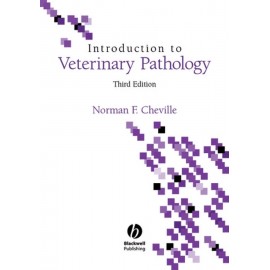Barra lateral
Introduction to Veterinary Pathology, 3rd Edition - Cheville
$131,119
Visto 918 veces
Descripcion del producto
2006 . Wiley-Blackwell . 392 Pages . Cloth. Introduction to Veterinary Pathology, Third Edition, is constructed for the beginning student in veterinary pathology, to introduce new scientific information on mechanisms of general tissue injury into the language of medicine. The basic concepts of pathology are integrated into clinical medicine. Chapters on cellular degeneration and necrosis, inflammation, thrombosis, hemodynamic disorders, and neoplasia have been reconstructed to include the latest in new scientific information and color illustrations of gross pathology. The revised 3rd edition also includes new chapters on infectious diseases, nutritional and metabolic diseases, ecosystems and environmental pathology, and forensic pathology and bioterrorism. . Preface.@pIntroduction.@p1. Overview: Injury, Death and Adaptive Responses.@pThe Language of Pathology.@pThe Diagnosis.@pNecrosis.@pAdaptive Responses to Injury and Altered Stimulation.@pPathologists at Work.@p2. Cell Death and Cell Recovery.@pNecrosis: Morphology and Mechanisms.@pApoptosis: Programmed Cell Death.@pCell Protection and Recovery.@p3. Cellular Responses to Sublethal Injury.@pMetabolite Overload.@pProtein Aggregation Disorders.@pAmyloid.@pCalcification.@pPigments.@pCrystals.@pConnective Tissue Substances.@p4. Inflammation.@pOverview.@pClinical Signs and Lesions.@pPathogenesis of Acute Inflammation.@pSystemic Signs of Acute Inflammation.@pChemical Mediators of Inflammation.@pChronic Inflammation.@p5. Repair: Wound Healing and Regeneration.@pRepair.@pAngiogenesis.@pFibrosis.@pEpithelialization.@pRegeneration.@p6. Hemostasis and Thrombosis.@pOverview.@pPrevention of Coagulation by Normal Endothelium.@pPlatelet Aggregation.@pBlood Coagulation.@pThrombosis.@p7. Hemodynamic Disorders.@pCardiovascular Disease and its Consequences.@pEdema.@pHemorrhage.@pShock.@pInfarction.@pEmbolism.@pCollateral and Compensatory Circulation.@pVascular Shunts and Fistulae.@pLymphatic Blockage.@pIschemia.@p8. Neoplasia:Characterizing the Neoplasm.@pOverview.@pBenign vs Malignant.@pMaking the Correct Diagnosis.@p9. Spread, Host Responses, and Genetics of Cancer.@pThe Spread of Neoplasms.@pClinical Effects of Neoplasms.@pRestraint of Neoplastic Growth.@pThe Genetic Basis of Cancer.@pThe Cancer Cell.@p10. Causes of Cancer.@pChemical Carcinogenesis.@pViral Oncogenesis.@pPhysical Agents Associated with Neoplasms.@p11. Immunologic Disorders.@pDisorders from Reduced Innate Immunity.@pDefects in Adaptive Immunity.@pHypersensitivity Disease.@pAutoimmune Disease.@p12. Genetic Disorders and Teratology.@pOverview.@pMutant Genes of Large Effect (Mendelian Disorders).@pMultifactoral (Polygenic) Inheritance Disorders.@pChromosomal Disorders.@pTeratology.@p13. Infectious Diseases.@pPrions.@pViral Diseases.@pBacterial Diseases.@pFungal and Algal Diseases.@pPathology of Parasitism.@p14. Nutritional and Metabolic Disease.@pNutritional Diseases.@pMetabolic Diseases.@pAging.@p15. Ecosystems and Forensic Pathology.@pAirborne Pollutants: inhalation toxicity.@pEnvironmental Pollutants.@pAquatic Ecosystems.@pAgricultural Hazards.@pWildlife Ecosystems: free ranging animals.@p16. Forensic Pathology.@pForensic Science.@pBioterrorism.@pIndex



